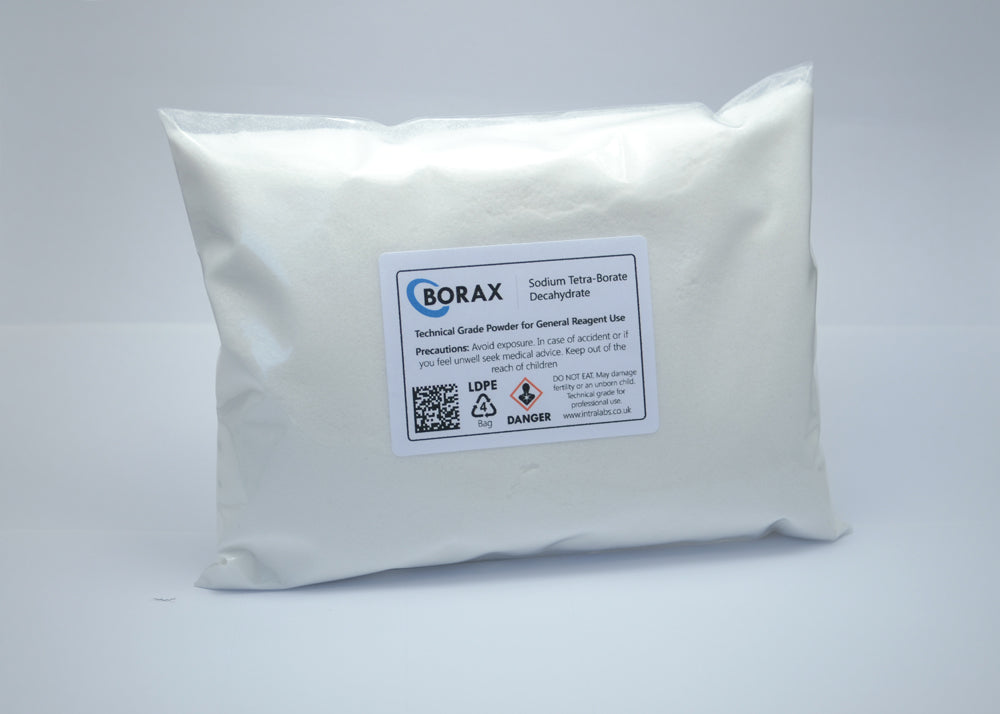
Sodium Tetra-Borate Decahydrate 99.9%
What is Borax?
Borax is a naturally occurring mineral deposit produced by repeated evaporation of lakes and riverbeds. The term Borax loosely refers several different chemical compounds based around the Sodium Tetraborate structure with varying number of water molecules attached to it. The most commonly occurring Borax compounds are: Borax Anhydrous (Anhydrous means “without water”), Borax Pentahydrate (Pentahydrate means 5 water molecules), Borax Decahydrate (Decahydrate means 10 water molecules). An example of the Borate anion structure which bonds ionically to Sodium (Na) and any water molecules is shown to the right.
Borax Properties
Borax (in any form) is a white crystalline solid at room temperature and is chemically stable under normal storage conditions; Borax Decahydrate has a molar mass of 381.38, its melting point is 1016 Kelvin (743 C) and its boilding point is 1848 Kelvin (1575 C). The solubility of Borax increases with water temperature; at 0C water temperature Borax will dissolve to produce a maximum % by weight saturated solution of 1.99% in contrast at 100C water temperature this increases to 65.64%. When dissolved in water Borax hydrolyses to produce a mildly alkaline solution which maintains a constant pH level.
Borax can be used for many things. I have listed some of its uses below, but this is by no means an exhaustive list, as borax has so many uses that I cannot possibly list them all here:
Borax is probably most well-known for its cleaning abilities. When mixed with water, borax produces a basic solution (of pH about 9.5), it also produces small amounts of hydrogen peroxide at the same time; these two properties make borax an extremely good cleaning agent, while not being toxic, dangerous or harmful to the environment. Some ways to clean are listed below:
Remove stains from rugs or carpets: Wet the area, then rub some dry powdered borax directly into the stain. Let the area dry, then vacuum or blot it with a solution of vinegar and soapy water. Repeat if required.
Remove urine odour from mattresses: Wet the area, then rub some dry powdered borax directly into the stain. Let it dry, then hover up the powder.
Cleaning windows and mirrors: Want streak free, squeaky clean windows and mirrors? Wash with a clean sponge dipped in 2 tablespoons borax dissolved in 600ml of water.
Remove mildew from upholstery fabric: To remove mildew from upholstery and other fabrics, soak a sponge in a solution of 125g of borax dissolved in 350ml of very hot water, and rub it into the area affected. Let it soak for a number of hours until the stain disappears, then rinse well.
Remove stubborn sink stains: Remove stubborn stains from your stain-less steel or porcelain sink. Make a paste of 250g borax and 60ml lemon juice. Put the paste on a cloth or sponge and rub it into the stain well, then rinse with running warm water.
Laundry Cleaning booster: ½ a cup of Borax in every load of wash along with detergent will boost the cleaning power of your detergent.
Deodorizing Rubbish Disposals: Sprinkle a 3-4 tablespoons of borax down the drain, leave for 30 minutes and flush the drain with warm/hot water.
Deodorizing Bins: Soak the bin with a mixture of hot water and 250g of borax to eliminate odours. After it has dried, add some dry borax powder to help prevent further smells.
Bodycare Products: Borax is also used when making body creams and lotions, shampoos, bath-gels, bath salt and bath bombs. It works as an emulsifier, a preservative, as a cleansing agent, and as a buffering agent.
Borax has the ability to soften the water and and also helps to suspend soap particles in the bathwater.
Is Borax Safe?
Product Safety - Risk Phrases: R60/61 - May impair fertility / May cause harm to the unborn child
Storage - Store in a cool, dry place away from moisture.

